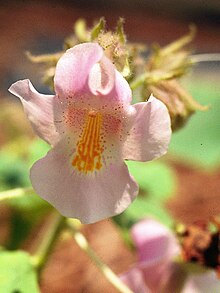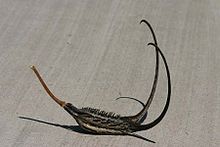Proboscidea louisianica
| Proboscidea louisianica | ||||||||||||
|---|---|---|---|---|---|---|---|---|---|---|---|---|

Blooming specimen of Proboscidea louisianica |
||||||||||||
| Systematics | ||||||||||||
|
||||||||||||
| Scientific name | ||||||||||||
| Proboscidea louisianica | ||||||||||||
| ( Mill. ) Thell. |
Proboscidea louisianica , also common devil's claw , is a species of the chamois horn family(Martyniaceae). The German common name Gemsenhorn is sometimesused. It is one of six species in the genus Proboscidea .
It is like the other chamois horn family, z. B. Ibicella lutea or the annual Martynia ( Martynia annua ), also known as devil's claw . However, it is not related to the genus devil's claws from the bluebell family.
description
Appearance and foliage leaf
Proboscidea louisianica is an annual plant with an extended or ascending stem and a height of up to 80 cm. The entire plant is covered with sticky glandular hairs. The opposite, later alternately arranged leaves on the stem are divided into a petiole and a leaf blade. The strong leaf stalks are 5 to 25 cm long. The simple, rounded leaf blade is kidney to heart-shaped with a diameter of 5 to 20 cm. The edges are wavy to dentate. The plants smell unpleasant.
Inflorescence and flower
Few stalked flowers stand together in a loose, 10–20 cm long, racemose inflorescence . The hermaphrodite flowers are zygomorphic and five-fold with a double flower envelope . The five 1.5–2 cm long and blunt to pointed sepals are fused. The five 4–6 cm long petals are fused; the crown is whitish to light pink as well as reddish to purple and has white-yellow and light pink sap marks .
Fruit and seeds
The unusually shaped, sticky and short-haired, belly-fissured capsule fruits are about 8-15 cm long, rounded, narrow-shaped and long-horned. They are initially light green, later orange-brownish, the exocarp is sloping. Below is the woody, hard, dark brown seed capsule ( diaspores , endocarp) (trampling burdock) made up of two long-horned, pitted halves that have grown together along the gap . It is 4.5–6.5 cm long and up to 2.5 cm wide and contains an average of 55 about 7–9 mm long and 4.5–5.5 mm wide, black-brown, flattened and egg-shaped seeds , with coarsely textured, corky seed coat. The long, slender, pointed, laterally protruding and bent back horns (chamois horns) are approx. 7–12 cm long. They are slightly shorter than those of Ibicella lutea . The horns are used for epizoochoric spreading, the diaspores stick to animals, which then trample them down and thus release the individual seeds.
Chromosome number
The number of chromosomes is 2n = 30
distribution
Proboscidea louisianica thrives in a total of 48 US states , in the Canadian provinces of Saskatchewan and Ontario it is naturalized. The plant is considered invasive and is considered a "weed" in some US states.
Taxonomy
This species was first described by Philip Miller in 1768 as a species of the genus Martynia . In the actual text he used the form of the name Martynia louisiana , but corrected that on one page with error corrections at the end of the work to Martynia louisianica . In 1912 the species was added to the genus Proboscidea by Albert Thellung . He used the corrected form of the name Proboscidea louisianica .
The generic name Proboscidea is derived from the Greek proboskis for " trunk " and refers to the shape of the fruit. The species name louisianica is borrowed from the natural habitat of the plant in what was then the colony of Louisiana .
Subspecies
Some authors differentiate between two subspecies.
- Proboscidea louisianica (Mill.) Thell. subsp. louisianica
- Proboscidea louisianica (Mill.) Thell. subsp. fragrans (Lindl.) Bretting : With reddish or purple flowers. It is native to Texas and Mexico and is a neophyte in Queensland and South Africa. But it is also listed as an independent species, Proboscidea fragrans .
use
In the southern states of America, pickled, steamed or sweetened semi-ripe fruits of Proboscidea species, but also those of Ibicella lutea and Martynia annua are considered a delicacy , they are also used as a substitute for okra . In Mexico, the seeds are consumed raw or roasted. The dried horns of the seed pods were used for braiding.
literature
- Le Roy Abrams & Roxana Stinchfield Ferris: An illustrated flora of the Pacific States: Washington, Oregon and California. Volume 4, Stanford University Press, Stanford (California) 1923-1960, p. 2, Chapter Martyniaceae online at biodiversitylibrary.org, accessed August 25, 2017.
- Forrest Shreve, Ira Loren Wiggins: Vegetation and Flora of the Sonoran Desert. Volume 1, Stanford Univ. Press, 1964, ISBN 0-8047-0163-6 , p. 1371.
Web links
Individual evidence
- ↑ Gerd K. Müller (ed.) U. a .: Rothmaler - excursion flora from Germany. Volume 5: Herbaceous ornamental and useful plants , Springer, 2007, ISBN 978-3-662-50419-2 , p. 480.
- ↑ Michael S. Riffle, W. Eugene Thilsted et al. a .: Germination and Seed Production of Unicorn-Plant (Proboscidea louisianica). In: Weed Science. Vol. 36, No. 6, 1988, pp. 787-791, JSTOR 4044789 .
- ↑ M. Horbens et al. a .: Cell differentiation and tissue formation in the unique fruits of devil's claws (Martyniaceae). In: American Journal of Botany. Vol. 101, No. 6, 2014, pp. 914–924, doi : 10.3732 / ajb.1400006 , online (PDF; 4.87 MB).
- ↑ Bruce G. Baldwin et al. a .: The Jepson Manual: Vascular Plants of California. Second Edition, Univ. of California Press, 2012, ISBN 978-0-520-25312-4 .
- ↑ Distribution overview of Proboscidea louisianica on plants.usda.gov (English); last accessed on September 12, 2018.
- ↑ Invasiveness report on Proboscidea louisianica on plants.usda.gov , section "Legal Status" (English); last accessed on September 12, 2018.
- ^ P. Miller: The Gardeners Dictionary. Ed. 8, 1768. - online
- ^ P. Miller: The Gardeners Dictionary. Ed. 8, 1768. - Corrections page - online
- ↑ Thellung A. 1911-1912: La flore adventice de Montpellier. Mémoires de la Société des Sciences Naturelles et Mathématiques de Cherbourg 38: 57-728. - p. 480 - online
- ↑ Helmut Genaust: Etymological dictionary of botanical plant names. 3rd, completely revised and expanded edition. Birkhäuser, Basel / Boston / Berlin 1996, ISBN 3-7643-2390-6 , p. 302 a. 507
- ^ Proboscidea louisianica (Mill.) Thell. at USDA , accessed August 25, 2017.
- ^ Proboscidea in the Germplasm Resources Information Network (GRIN), USDA , ARS , National Genetic Resources Program. National Germplasm Resources Laboratory, Beltsville, Maryland. Retrieved December 23, 2017.
- ^ Judith Sumner: American household botany: a history of useful plants, 1620-1900. Timber Press 2004, ISBN 0-88192-652-3 , p. 167 and 168.
- ↑ Delena Tull: Edible and Useful Plants of Texas and the Southwest. Univ. of Texas Press, 1987, 2003, ISBN 0-292-78164-4 , pp. 121.
- ↑ William C. Sturtevant, Warren L. D′Azevedo: Handbook of North American Indians . Vol. 11: Great Basin , Smithsonion Institute, 1986, ISBN 978-0-16-004581-3 , p. 402.

